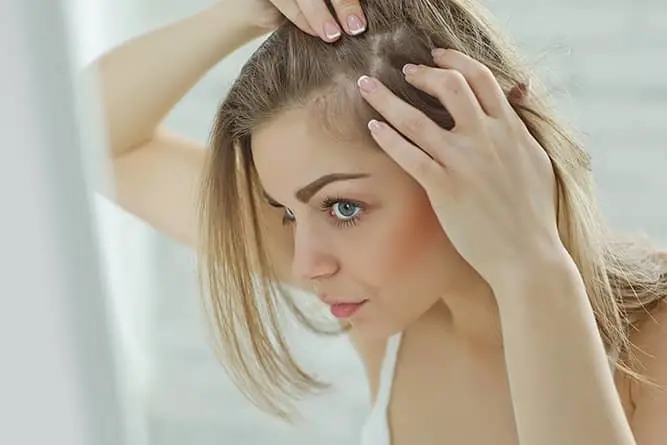Your hair has a life expectancy that falls anywhere between two to five years as it goes through a process of growth, transition, and rest. There are certain medical concerns and routines that can cause more of your hair to fall out during the rest cycle. Regardless of why your hair is lost, there are some treatments to follow to prevent hair loss in men and women. 96
One-third of women will experience hair loss (alopecia) at some point in their lives. Women's hair loss often has a greater emotional impact than men's hair loss because it is less socially acceptable for them.97 Nonetheless, the most common cause of hair loss in women is the same as it is in men. Androgenetic alopecia, or female (or male) pattern hair loss, is the medical term for this condition. 98
Hair loss in men typically begins above the temples, with the receding hairline eventually forming a distinctive "M" shape; hair on the top of the head also thins, often progressing to baldness. Androgenetic alopecia manifests itself in women as thinning of the hair line and a visible hair loss from the top of the head. Women's hairlines rarely recede, and they rarely go bald.99
Nevertheless, it is important to know that all men and women both experience some degree of hair loss as they age, a variety of medical treatments are available to prevent hair loss or to reduce hair loss, and hair transplantation can be used. 100
Treating female-pattern and male-pattern baldness 101
Female-pattern and male-pattern baldness has no cure, but treatments can slow the progression of hair loss. Minoxidil and finasteride are the two most effective treatments. Minoxidil is also available as a lotion that can be applied to the scalp. Wigs, hair transplants, and plastic surgery procedures, such as scalp reduction, are also options for reducing hair loss.
As preventative measures to hair loss in men and women, keep track of the following ways to prevent hair fall: 102
Hairstyles that pull on your strands, such as braids, ponytails, or buns, can put too much pressure on your hair and damage follicles.
Heat tools, such as curling irons and blow dryers with brushes, should be used with caution. If you must use these tools, use them on the lowest setting possible. Do not forget to protect your hair with a heat-protecting spray.
Straightening, bleaching, or lightening hair can cause damage to the hair shaft if done excessively.
Increase your intake of vitamin-rich foods like iron, zinc, and vitamin B12 through diet or dietary supplements to help revitalize thinning strands.103
Condition the scalp with essential oils. Massaging a few drops of rosemary, cedar wood, lavender, or clary sage into your head can energize your scalp.104
Consider using Regaine® as a product to reduce hair loss. Regaine contains minoxidil. Minoxidil is a drug that comes in the form of a cream or in the form of a spray or foam. There are male and female-specific formulations available. Minoxidil is expected to prolong the growth phase.
In conclusion, while reducing and treating hair loss might lead to desirable effects in some cases, it is very important to continue practice routines and habits that prevent hair loss in men and women. Other than physical appearances, hair loss may impact the emotional well-being of men and women given that many believe that their hair is part of who they are. Therefore, make sure you follow the strategies mentioned above to prevent hair loss, to keep your hair healthy, and to energize your scalp!105
References:
97 https://www.health.harvard.edu/staying-healthy/treating-female-pattern-hair-loss
99 https://www.health.harvard.edu/staying-healthy/treating-female-pattern-hair-loss
100 https://www.betterhealth.vic.gov.au/health/conditionsandtreatments/patterned-hair-loss
101 https://www.aarp.org/home-family/friends-family/info-2017/reasons-for-hair-loss-in-women-fd.html
102 https://health.clevelandclinic.org/how-to-stop-hair-loss/
103 Almohanna, H. M., Ahmed, A. A., Tsatalis, J. P., & Tosti, A. (2019). The role of vitamins and minerals in hair loss: a review. Dermatology and therapy, 9(1), 51-70.
104 Hay, I. C., Jamieson, M., & Ormerod, A. D. (1998). Randomized trial of aromatherapy: successful treatment for alopecia areata. Archives of dermatology, 134(11), 1349-1352.
105 Marks, D. H., Penzi, L. R., Ibler, E., Manatis-Lornell, A., Hagigeorges, D., Yasuda, M., ... & Senna, M. M. (2019). The medical and psychosocial associations of alopecia: recognizing hair loss as more than a cosmetic concern. American Journal of Clinical Dermatology, 20(2), 195-200.

